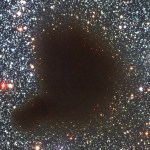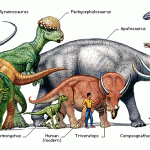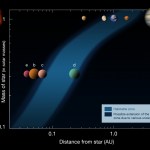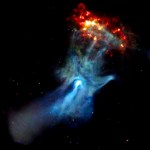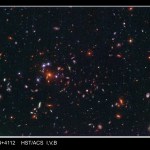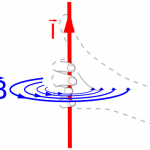
Stars are like everything else in the Universe (to quote E.B. White): we're born, we live a little while, we die. The thing that people may not realize is this: stars have been doing this since before the Universe was visible! What do I mean by this? Take a look at this nebula, Barnard 68.
What's going on here? This is what astronomers call "dust", and what everyone else on Earth calls "neutral hydrogen atoms." Yes, puny mammal, practically all of the atoms in space are ionized hydrogen, and this is a good thing. How does this happen? You form stars, and the high-energy light (Ultra-Violet…
For over 100 million years, dinosaurs, and not mammals, were the dominant form of life on Earth. The pinnacle of evolution at the time, dinosaurs filled the niches of being the largest, most differentiated animals -- herbivores and carnivores both -- on the planet. As you well know from seeing their fossils, they would dwarf their modern, mammalian counterparts if they were still alive today.
But they're not still alive today, because a mass extinction event occurred 65 million years ago. And the fossil record indicates that it occurred all at once, which is unusual. The Earth was overrun…
Do you remember when music videos were brand new things, and ranged from Cartoonish Violence to Eclectic Pleas for Individual Freedom? Well, one of my favorite videos was by the Norwegian band A-Ha, whose surreal, romantic fantasy video for their single Take On Me won me over instantly. I think it holds up pretty well, even nearly 25 years later:
But someone had the brilliant idea of changing the lyrics around to actually match what's happening in the video. Have a few of those weekend beers, and then check out the literal version of A-ha's Take On Me:
And -- if you like -- you can…
As many of you have heard, the Earth has been getting warmer, rapidly, since the industrial revolution. And as many of you have also heard, there is, historically, a link between greenhouse gases and temperature here on the Earth.
So, with Earth Day just behind us, I thought of a little analogy for the one question I hear more than any other about global warming:
How could something as small as a human being affect the climate/temperature of the entire Earth?
The analogy is good old-fashioned water torture. What harm can one drop of water do to you? Pretty much nothing, of course. But what…
There are many ways to celebrate Earth Day, from sustainability efforts (and check out our new blog, Guilty Planet) to simply appreciating nature.
And while this is a beautiful shot of Forest Park right here in Portland, it doesn't compare -- in my eyes -- to the perfection of Earth as seen from so far away.
In October of 1946, a V-2 missile was launched from New Mexico, straight up into the air. And at its maximum height of 65 miles (just barely into what was then considered outer space), it snapped the first photographs of the Earth from Space. (And you can click every image on this page…
In addition to the article I just wrote about the newly discovered planet in the Gliese system, Dynamics of Cats has a great writeup as well.
They also have a picture that I didn't include in my original post, and it's so good that I'm including it here:
Take a look at that. Two of the planets, Gliese 581 c and Gliese 581 d, are just on the theoretical edges of the habitable zone. And there's a whole looooot of space in between them. In our Solar System, that's not how it works. We don't have a gas giant mixed in with the rocky planets, and we don't have a gap the size of the habitable zone…
One of the holy grails of modern astrophysics is to find a planet orbiting another star that can support life on it. There are all sorts of missions dedicated to searching for habitable worlds.
But with one star system, Gliese 581, we may have hit the jackpot. To look at Gliese 581 in the sky, it doesn't look like much.
It's a red dwarf star, and a much smaller star than our own Sun. It weighs in at only about 30% of the mass and size of our Sun, and it's estimated to be twice as old. But at only 20 light-years from us, it's pretty close, for another star.
So what makes it so important?
It'…
The Sun is doing something interesting, and has been for the last few years. As a solar physicist noted last year, there really haven't been many sunspots lately. Look at 2001 (left) and 2009 (right) for the difference in sunspot activity.
But there's more. In addition to virtually no sunspots, the Sun is having fewer solar flares, hit a 50-year low in solar wind pressure, and is at a 55-year low in radio emissions. This is in addition to sunspot activity, which is at a 100-year low!
Well, Professor Mike Lockwood, an expert in long-term solar variations, has been keeping tabs on our Sun. As…
You've seen it a bunch of times when you're reading the specs on a new car: the number of foot-pounds of torque that it puts out. Well, the 2009 New York Auto Show just happened, and I was reading the synopsis of a new Mercedes that just came out:
369 foot-pounds of torque, it says. (That's 500 Newton-meters, for you mks/SI folks.) Torque is the amount of "turning power" you have, much in the same way you turn a wrench. 369 foot-pounds means that if you had a wrench that was 1 foot long, and applied a force of 369 pounds directly perpendicular to that wrench, you would get 369 foot-pounds of…
Someone at the New York Daily News must have started celebrating April 20th a bit early. Because this beautiful supernova remnant, with a spinning, pulsing neutron star at the center:
is no excuse to run a poll asking readers if this is either the Hand of God or a natural stellar formation.
I could tell you about the power of PZ, and how since writing his post last week the numbers have gone from 40/60 to 5/95, but I'd rather tell you the one thing that every lefty knows: God is right-handed.
Thanks a lot -- on behalf of all lefties -- for the reminder, big guy.
In celebration of April 20th, I thought I'd show you a method for making fire that's so neat it will work -- without fuel or chemicals -- both on Earth (left) and in space (right).
We're going to do it without a match, without a lighter, and without friction. That's right, the next time someone needs a light, I'll show you a way to make one that even beats rubbing two sticks together!
Image credit: Gideon Mendel/CORBIS.
Have you ever read the book Fahrenheit 451? The title refers to the temperature -- 451 degrees Fahrenheit (233 Celsius) -- at which paper will spontaneously, in the…
Our song this week comes from the little-known band Elsinore, based out of Champaign, IL, and named after a city (with a great landmark) in Denmark. (Hi, Sili!) They've got just a couple of albums out so far, but here's one of my favorites for you to listen to -- the song Cannonballs off of Nothing By Design -- which you can download here.
While you listen, here's something I've been thinking about. I always worry about the scientific process of "data collecting" when you rely on humans to self-report accurately. The most notorious example is that we still don't know how long the typical…
How old is the Solar System? We know now, from a variety of astronomical, geological and solar evidence that we're looking at about 4.5 billion years. But in the 19th century, there was a huge problem. Here's why.
On one hand, you had evolutionary biology and evolutionary biologists.
Charles Darwin had discovered not only that organisms evolve, but had determined the mechanism of natural selection. His voyage on the HMS Beagle had allow him to make the observations necessary to confirm the validity of his theory and its mechanism.
A little bit about geology and the age of the Earth was known…
It seems like it was just last week that I wrote about colliding dark matter, showing what happens when two galaxy clusters collide.
Well, nature has gone and one-upped me. Let me explain. Galaxy clusters are huge conglomerations of matter: normal matter (protons, neutrons, electrons, etc.) and dark matter (this mysterious, non-collisional stuff). We find them all over the place, and they can contain anywhere from a handful to thousands of galaxies. They are spectacular sights, and I'll give you one below.
But one thing these galaxy clusters do, even today, is continue to gravitationally…
Yesterday, after a long day, my wife and I settled in for some time to chill out, and turned on the TV. Although I'd never watch it on my own, I know my wife is a fan of watching The Biggest Loser, so I joined her for an episode last night. And to be completely fair, I think it's a wonderful thing to help make people conscious about their bodies, their diet, their lifestyle, and how to have the life they want. The results of the people who succeed at this are truly spectacular.
They're doing "couples" this season; there are mother-daughter teams, father-son, husband-wife, sisters, best…
Oh, yes, yes they do turn pink. You may be used to plain old "boring" spiral galaxies, like my buddy M74 over here.
A number of these galaxies happen to be "face-on" to us, so we can really get a good glimpse of what's going on in their individual spiral arms. Many of them, like the Pinwheel Galaxy (M101), are pretty unremarkable, and are just a dusty whitish-blue color. But if we take other, similar galaxies, like NGC 3184, we find something interesting. Specifically, we find a few areas in these spiral arms that are pink.
This is not false color, either. This is plain-old visible light.…
If you show people a cloudy, overcast day side-by-side with a bright, sunny one, almost everyone will choose the sunny day as the one that makes them happier.
Dave, one of Starts With A Bang's longest readers, is no exception. The extended winter he's living through in Kansas isn't making him any happier:
Someone remind me what the Sun looks like, it's been a couple of days since I've seen it....
No problem, Dave. Sure, there are good reasons that you want to see the Sun, for the effects it has on regulating your circadian rhythms, on the release of various endorphins, for Vitamin D…
I don't normally post about science on the weekends, but this is too good to not tell you. Back in January of 2004, we successfully landed two rovers -- Spirit and Opportunity -- on opposite hemispheres of Mars. The views were immediately spectacular (click image for the full version).
Initially slated for 90 day missions, these two rovers have now been on Mars for more than 1800 days, and are still functional. But there are some things that we didn't plan for, because we didn't plan on the missions lasting this long and the rovers being this good. Take a look at this panorama of Endurance…
What better way to celebrate Easter weekend than with an old spiritual song about the birth of Jesus? This is the gospel song Last Month of The Year -- an old Southern American Spiritual -- sung and arranged by Jackson C. Frank. This is my favorite version of the song by far, as I really like its simplicity and the minor tones to go along with it. Take a listen:
alt : Last Month of the Year.wavWell, Good Friday is when he died, and then we have the following Bible Quotes to go off of to figure out what came next:
Acts 2:24 -- But God raised him from the dead, freeing him from the agony of…
Everyone who's taken physics at some point knows about the Right Hand Rule. There are two versions. If you have a wire carrying an electric current, you point your thumb in the direction of the current and your fingers "curl" in the direction of the magnetic field.
The other version is that if you have two out of the following three -- current, magnetic field, and a force -- the right hand rule can help you find the direction of the third one that gets induced from the other two:
Well, there's one really annoying thing about this rule: it requires the current to be moving positive charges!…
